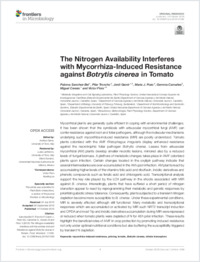The nitrogen availability interferes with mycorrhiza-induced resistance against Botrytis cinerea in Tomato
- Sanchez-Bel, Paloma Metabolic Integration and Cell Signaling Laboratory, Plant Physiology Section, Department of Ciencias Agrarias y del Medio Natural, Universitat Jaume I, Castellón, Spain
- Troncho, Pilar Department of Ciencias Agrarias y del Medio Natural, Universitat Jaume I, Castellón, Spain
- Gamir, Jordi Metabolic Integration and Cell Signaling Laboratory, Plant Physiology Section, Department of Ciencias Agrarias y del Medio Natural, Universitat Jaume I, Castellón, Spain - Department of Biology. University of Fribourg, Switzerland
- Pozo, Maria J. Department of Soil Microbiology and Symbiotic Systems, Department of Ciencias Agrarias y del Medio Natural, Universitat Jaume I, Granada, Spain
- Camañes, Gemma Bioquímica y Biotecnología, Plant Physiology Section, Department of Ciencias Agrarias y del Medio Natural, Universitat Jaume I, Castellón, Spain
- Cerezo, Miguel Metabolic Integration and Cell Signaling Laboratory, Plant Physiology Section, Department of Ciencias Agrarias y del Medio Natural, Universitat Jaume I, Castellón, Spain
- Flors, Víctor Metabolic Integration and Cell Signaling Laboratory, Plant Physiology Section, Department of Ciencias Agrarias y del Medio Natural, Universitat Jaume I, Castellón, Spain
-
2016
Published in:
- Frontiers in Microbiology. - 2016, vol. 7, p. 1598
English
Mycorrhizal plants are generally quite efficient in coping with environmental challenges. It has been shown that the symbiosis with arbuscular mycorrhizal fungi (AMF) can confer resistance against root and foliar pathogens, although the molecular mechanisms underlying such mycorrhiza-induced resistance (MIR) are poorly understood. Tomato plants colonized with the AMF Rhizophagus irregularis display enhanced resistance against the necrotrophic foliar pathogen Botrytis cinerea. Leaves from arbuscular mycorrhizal (AM) plants develop smaller necrotic lesions, mirrored also by a reduced levels of fungal biomass. A plethora of metabolic changes takes place in AMF colonized plants upon infection. Certain changes located in the oxylipin pathway indicate that several intermediaries are over-accumulated in the AM upon infection. AM plants react by accumulating higher levels of the vitamins folic acid and riboflavin, indolic derivatives and phenolic compounds such as ferulic acid and chlorogenic acid. Transcriptional analysis support the key role played by the LOX pathway in the shoots associated with MIR against B. cinerea. Interestingly, plants that have suffered a short period of nitrogen starvation appear to react by reprogramming their metabolic and genetic responses by prioritizing abiotic stress tolerance. Consequently, plants subjected to a transient nitrogen depletion become more susceptible to B. cinerea. Under these experimental conditions, MIR is severely affected although still functional. Many metabolic and transcriptional responses which are accumulated or activated by MIR such NRT2 transcript induction and OPDA and most Trp and indolic derivatives accumulation during MIR were repressed or reduced when tomato plants were depleted of N for 48 h prior infection. These results highlight the beneficial roles of AMF in crop protection by promoting induced resistance not only under optimal nutritional conditions but also buffering the susceptibility triggered by transient N depletion.
- Faculty
- Faculté des sciences et de médecine
- Department
- Département de Biologie
- Language
-
- English
- Classification
- Biological sciences
- License
- License undefined
- Identifiers
-
- RERO DOC 278405
- DOI 10.3389/fmicb.2016.01598
- Persistent URL
- https://folia.unifr.ch/unifr/documents/305294
Other files
Statistics
Document views: 74
File downloads:
- gam_nai.pdf: 213
- gam_nai_sm.pdf: 114

